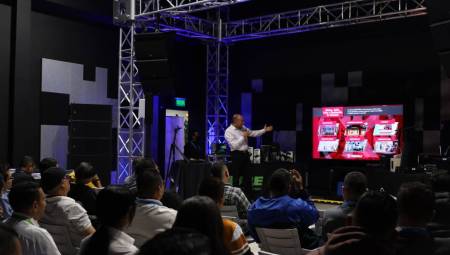Mexico. Many adults remember times when technology in classrooms did not go beyond a projector, a radio and perhaps a personal computer. Today, most teachers use school-supplied laptops to teach.
It would not be surprising if students follow it from other laptops that are stored in the classroom. The set of laptops could be complemented with other elements, such as smart boards, streaming media players and printers, and of course, there are also the personal smartphones of the students. All kinds of connectivity. ESET, a leading company in proactive threat detection, through its Digipadres initiative, analyzes how technology is changing in the modern classroom and what we can do to protect it.
Most devices are connected to some network. According to EducationSuperhighway, 99% of U.S. schools have scalable fiber Internet connection and more than 43 million students have an Internet connection. This means that students can use the devices to access websites, collaboration software programs and other applications, beyond attending school in person or from home.
"Unfortunately, there is no universal and 100% foolproof solution to protect children who use technology. For example, just because a child's smartphone blocks access to content from inappropriate websites doesn't mean their classmate's smartphone does too. So, the question is how can we keep our children safe while using classroom technology?" says Camilo Gutiérrez Amaya, Head of the Research Laboratory at ESET Latin America.
ESET recommends familiarizing yourself with some of the best practices to keep children safe online and making a list of the devices, software and technology that is used daily. Most will fall into the following five categories:
Laptops, tablets and smartphones: According to EducationSuperhighway cited above, 87% of teachers say they use digital learning media in their classrooms several times a week. Although there are many modalities, the predominant devices are: laptops, tablets and smartphones.
For school-supplied devices, check that the institution has a security policy in place to monitor access and control content. In addition, you should ask them some questions such as: When students are in school, are they allowed to use the devices to access the Internet, communicate with others or even participate in classroom activities?
In the case of personal devices, such as smartphones, you can consider installing a security solution for mobile devices in order to control the use of the devices both inside and outside the school.
Learning management systems: This system makes up at least part of the daily experience of students in the classroom. It is a software program that can be accessed from any device or web browser, with the aim of uploading documents and accessing them, scheduling homework, grading tests and much more.
Most of these tools are considered quite reliable because of the absence of ads and spam, as well as their secure access. However, certain platforms like Google Classroom have message boards that are difficult to moderate, and often give space for students to send inappropriate messages. In this case, adults should guide them in their correct use and talk to them about acceptable behavior when sending messages, sharing files and interacting in another way through the platform.
Email: Ideally, communications by instant messaging or email should be carried out in a controlled environment, such as through the learning management system. However, it is not uncommon for students to have their own email addresses and use them to communicate with teachers and other students.
First, it's important to teach children security best practices and identify email threats. Phishing, for example, remains one of the top security threats in email. Sharing passwords, personal information, and even sensitive media files like photographs is another common email vulnerability. Finally, many children do not know that they should not open suspicious or unknown files. Chat about all of these topics and teach them to think twice or consult before clicking on something or sharing information via email.
Video, collaboration, and social learning platforms: In many learning management systems, collaboration, and social learning platforms, video is one of the ways students share their work, comment, or even send messages. Solutions like Flipgrid and Padlet are examples of so-called social learning platforms, in which students can share their work and interact with the work of others, all moderated by the instructor (they support heavy videos).
The two main security concerns are access and moderation. Controlling access to these platforms should be a priority. For example, although Zoom classrooms can be protected with a password, they are not immune to unwanted intrusions (Zoombombing). Moderating what is shared, said or sent on these platforms can also be challenging. ESET recommends looking for solutions that offer protection mechanisms for accessing and sharing, as well as robust functionalities to moderate student interactions.
Games: One of the most recent trends is gamification in the classroom. Instead of relying on textbooks, schools are turning to interactive and fun software programs that encourage greater student engagement. Solutions like Gimkit or Kahoot! offer a variety of games and activities in which students earn points, badges and level up by participating. While the security concerns related to these platforms are less important than the others, it is still a modern technology for the classroom that parents should be aware of.
"Again, the main thing is for children to connect to the classroom, learn effectively, and stay safe. When it comes to children's safety in the modern classroom, awareness wins half the battle. While this list of modern technological resources for the classroom is quite detailed, technology will continue to evolve at a breakneck pace. Parents can go a long way toward protecting their children by simply keeping up with what's going on and what their children use in the classroom. Beyond being informed and aware, parents can educate themselves and their children about the best safety practices for being online. These best practices are applied regardless of the technology, device or interface used, and no matter how fast the technology evolves," concludes Gutiérrez Amaya, from ESET Latin America.
ESET advises parents to use purpose-built security solutions to keep children safe while using their personal devices. Many schools already protect their own devices, including those they give to students. However, parents can add another layer of protection to the personal devices that children use to connect from home.
Text published by ESET.
















